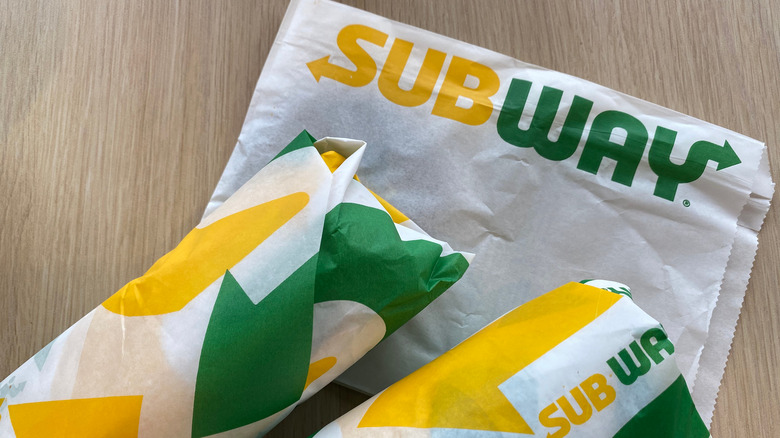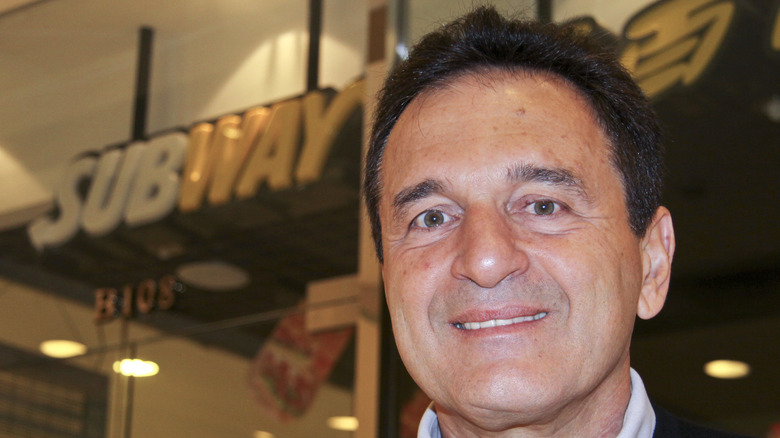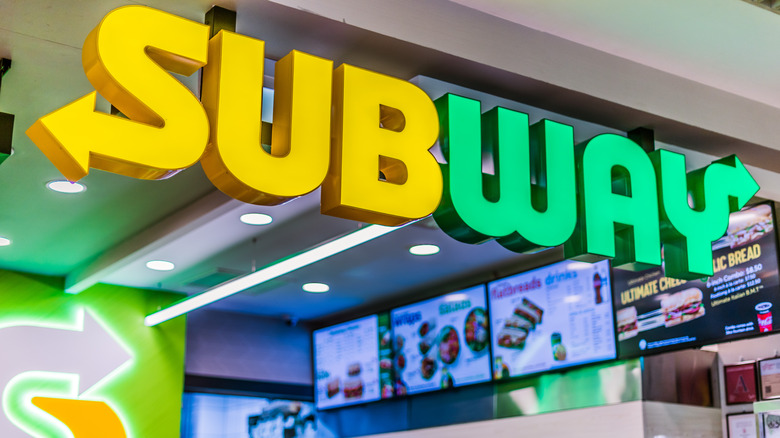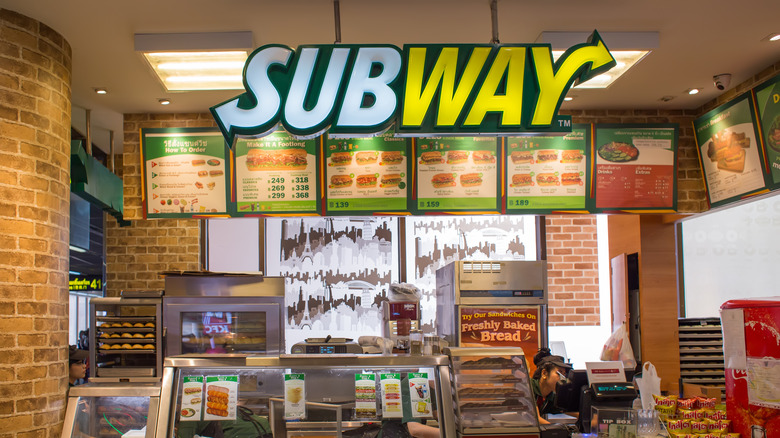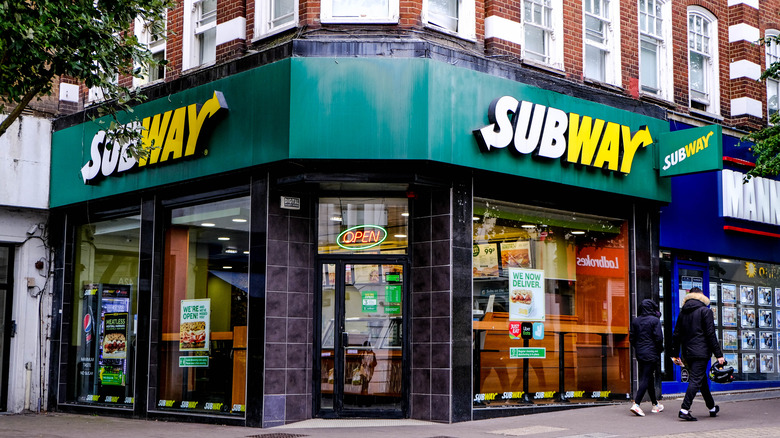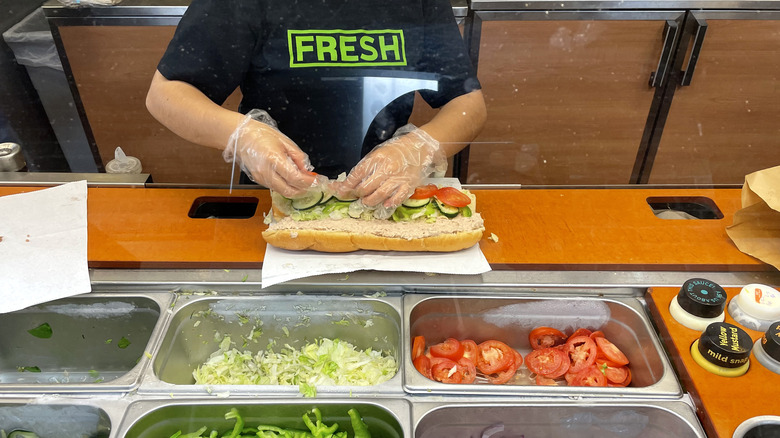What You Didn't Know About The First Subway
Nowadays, you'll have no trouble finding a Subway restaurant somewhere nearby, but that was far from the case 50 years ago. According to its own history, Subway, which was originally named Pete's Super Submarines, was the brainchild of two men. One was a college freshman trying to figure out how he'd pay his tuition, while the other was a nuclear physicist who decided that the pair should start a sandwich place. In 1965, with a mere investment of $1,000, Pete Buck and Fred DeLuca opened the first of what would eventually become more than 40,000 Subway locations in Bridgeport, Connecticut (via Subway).
With their three core principles in place — providing excellent service, high quality at low prices, and keeping operating costs down — it took less than 10 years before the duo was running 16 different Subway restaurants. But that was hardly enough, given that their original plan was to operate 32 restaurants. Then, the idea that really put them on the fast food map came to them: franchise. But that's not the whole story. Here's what you didn't know about the first Subway.
Fred DeLuca was a worried college kid
Before heading up a multibillion-dollar enterprise, Fred DeLuca was just a New York kid who was born in Brooklyn and grew up in the Bronx. According to Fox Business, his family moved around a bit more after that before finally settling down in Bridgeport, Connecticut. This was the city that would later become home to the place that would revolutionize the sub sandwich game. But in 1965, after having graduated from high school, DeLuca wasn't there just yet. Already putting in work at a local hardware store, he still found himself fretting over how he would ever be able to pay his college tuition. Then, in came Pete Buck.
Pete Buck was a friend of the DeLuca family. Trying to come up with a solution for the young man's tuition worries, he suggested opening a sandwich shop in which he'd invest a thousand dollars. Ultimately, in one day, the 17-year-old DeLuca sold 300 sandwiches that were priced between 49 to 69 cents each. At that rate, the initial cost of opening would have been covered in only a couple of months. Little did he know that, with the help of Pete Buck and some time, he'd be going from worrying about college tuition to a billionaire.
Pete Buck was a scientist and investor
While Fred DeLuca was only a college freshman and part-time worker at a hardware store, Pete Buck was already quite the established figure. According to Hartford Business, he was a nuclear physicist and resident of Danbury, Connecticut long before becoming an entrepreneur. One might presume that, while DeLuca was hungry to work, Buck may have just been literally hungry when he first suggested a sandwich-based business venture.
According to The Takeout, it all started at a barbecue when the younger DeLuca asked Buck for advice. You can only imagine what it would have been like for DeLuca, who asked for some guidance during a family picnic and walked away with not only a business partner but a $1,000 check. What's more, he had some pretty serious support in other ways: Buck told him that he'd take care of the financial aspect as long as the DeLuca ran the shop itself.
Major expansions helped Subway grow
Subway didn't become one of the biggest fast food shops in the world overnight. In fact, according to Success Story, the store's profits weren't exactly sky high by the end of its first summer. It's said that it had only made six dollars in net profits. While someone else might have tried to cut their losses at this point, the duo instead opened a second location nearby. And when that venture didn't fare as well as they had hoped, they went ahead and opened a third location. For them, this eventually showed that persistence and a strong business model would eventually pay off, as, in a little less than 10 years, they had 100 sandwich shops open and were doing pretty well.
From 100 stores in 1978 to almost 41,000 by 2013 (via Success Story), Subway proved to be one of the fastest-growing fast food chains the world had ever seen. 1984 brought their first sandwich shop located outside the US, on the Middle Eastern island nation of Bahrain. While they may not be sold in the same currency or unit of measurement, now you can find yourself a five-dollar footlong (or its equivalent) on just about any corner of the map, from Hong Kong to Norway to Bridgeport, Connecticut.
The other side of Fred DeLuca
On paper, the story of Subway sounds like a fairy tale: with a surprise helping hand from a fairy godfather, a young man from nowhere opens a sandwich store to fund his education. Eventually, that sandwich shop becomes one of the biggest fast food enterprises in history. However, it appears that there is another side to the story's hero. According to Business Insider, Fred DeLuca's rags to riches story may have turned him into a more complicated figure than a good-hearted college kid gone big.
One of the weirder things DeLuca did at Subway was to create a calendar featuring photos of Subway executives. Sounds simple enough, but it gets weirder when you learn that the calendar featured not only a shirtless DeLuca but an image of another executive in the shower. While that may have created a strange atmosphere in the offices, it is also known that DeLuca had a penchant for targeting the wives of franchise owners. He would approach them at conventions, framing himself as the overall reason for their husbands' successes. While his reputation behind the scenes may have been creepy and worthy of a harassment suit, Fred DeLuca's image wasn't the only thing that Subway needed to worry about.
Subway has experienced some serious ups and downs
Though Subway is still a major player in the fast food game, the years haven't always been so kind to the worldwide sub supplier. According to the Washington Post, Subway has had some serious problems in recent times — and, no, their names aren't all Jared, though that particular scandal was definitely a major blow to the brand.
For years, Subway had presented itself as a healthy alternative to fast food. It's cheap, convenient, and you can have it in mere moments, after all. First Lady Michelle Obama even lauded them for helping to get kids to eat their veggies (via The White House). Despite relying on its healthy and fresh image, however, it's clear that Americans' view of Subway has changed with the advent of new alternatives.
Though Subway managed to open so many locations through franchising that they almost compete with themselves, newcomers on the fast food scene have damaged Subway's fresh image. Places like Chipotle and even Taco Bell (yes, really) have introduced a new level of freshness and quality that has, in turn, hurt the Subway's reputation as a healthy alternative to Big Macs and Whoppers.
